When I go to a kosher bakery anywhere in the world, I look for poppy seed rolls. I love them for their delicate and shiny pastry and for their sweet, inky, fruity and slightly bitter poppy seed filling. I especially love poppy seed rolls in the morning, alongside a strong cup of coffee or black tea. It’s a decadent deviation from a sensible breakfast, and it’s especially good on a Shabbat morning.
The sweet poppy seed roll is common in Jewish and non-Jewish communities in Central and Eastern European countries from Hungary, to Poland, to Ukraine, to Romania and more. It is particularly popular during the winter holidays. In my family, my father and I have always been big fans of this pastry, and we will search high and low for a bakery that offers the best version of it. We will try different rolls and debate the finer points of each pastry: Was it too sweet? Was the ratio of poppy seed to pastry good? Was the pastry soft enough?
There’s a reason that poppy seed rolls don’t seem to be a wildly popular baked good — they are a bit fussy to make. The pastry is made of an enriched dough; it takes time for the dough to get kneaded into a silky smooth mass, it takes time for the dough to rise, and it takes a little focus and care to shape and form the rolls. The poppy seed filling also takes a little work, although you can buy pre-made poppy seed filling in a can if you want to make your life easier. One must grind the poppy seeds in batches, heat up several ingredients and be patient with chilling time. Patience is part of the poppy seed roll process.
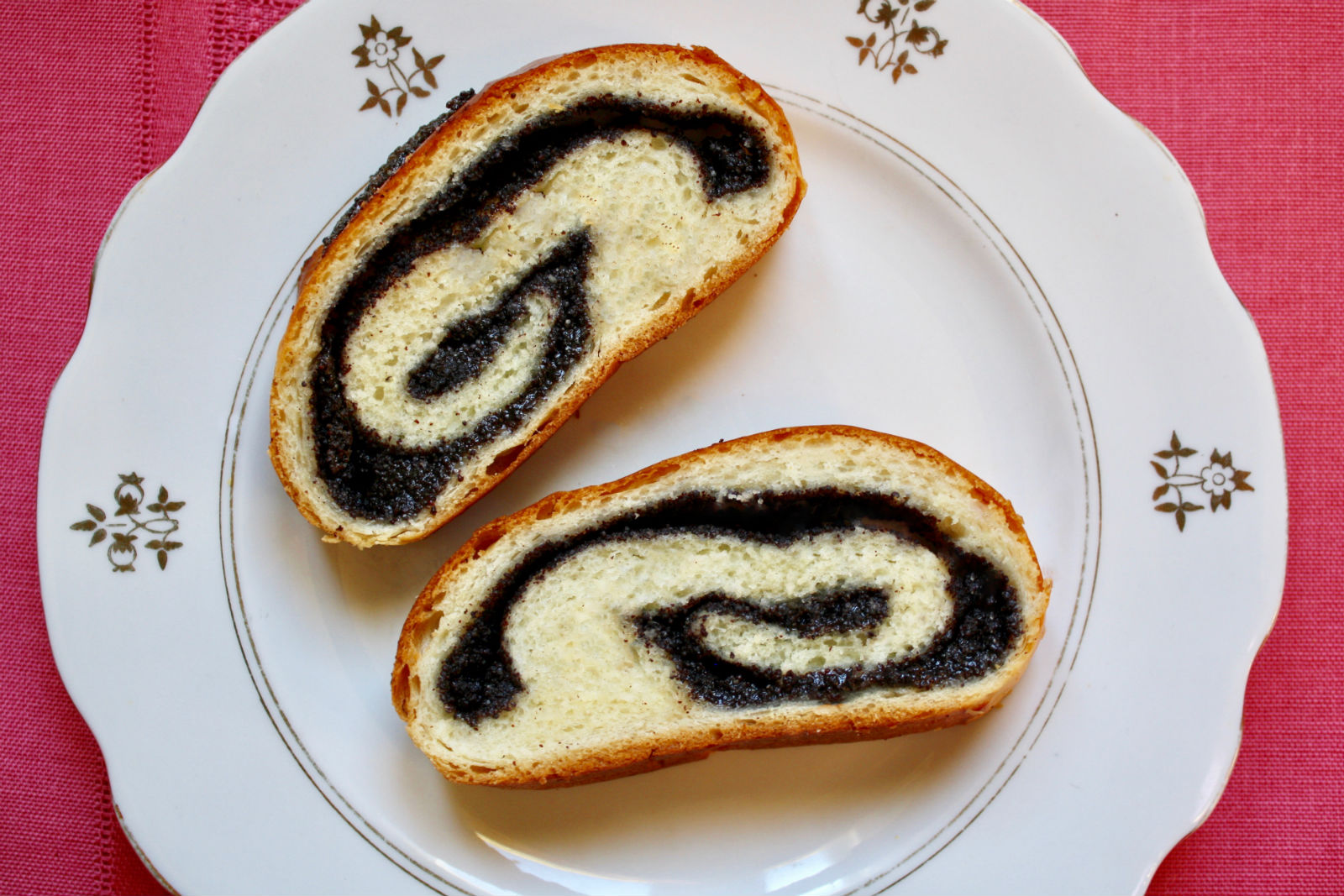
And yet, this is the kind of pastry that, when baked at home, offers both nostalgic satisfaction and a sense of accomplishment. The dough is so smooth and inviting to work with and the poppy seed filling is glossy and pleasingly deep in color. While making this, you might feel like you’re a contestant on the “Great British Baking Show” in an episode where they’ve asked you to make an “Old World Classic” for the technical challenge. You might nervously hope that the filling doesn’t leak, that the dough has neither over- nor under-proofed, and that there is a perfect swirl of poppy seeds inside when it is finally cooled and you make your first slice.
The Nosher celebrates the traditions and recipes that have brought Jews together for centuries. Donate today to keep The Nosher's stories and recipes accessible to all.
When I’ve made this, sometimes my pastry did leak, and sometimes the swirl was not as perfect as I’d hoped for, and yet the flavor never suffered for it. Tasting the still warm roll in any of its forms always seems to erase the memory of the labor and any perceived imperfections. Fresh out of the oven and (patiently) waiting for the rolls to cool a bit, the kitchen gets filled with buttery, nutty, vanilla smells and nothing feels more homey than that.
Notes:
- You can make the filling 1-2 days in advance and store it in the fridge.
- The dough needs to rise for around 1½ hours.
- Poppy seed rolls can keep up to five days in an airtight container.
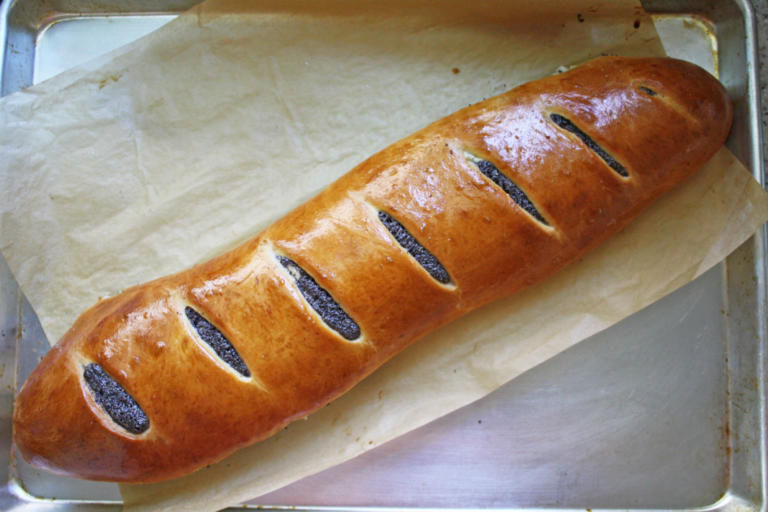
Poppy Seed Roll
A bake that brings nostalgic satisfaction and a sense of accomplishment.
- Total Time: 3 hours 40 minutes
- Yield: 10-12
Ingredients
For the poppy seed filling:
- 8 oz poppy seeds (1½ cups), very fresh
- 2 Tbsp unsalted butter
- ½ cup milk
- ⅔ cup sugar
- 2 Tbsp honey
- 2 tsp pure vanilla extract
- big pinch of salt
For the dough:
- 4¼ cups (585 g) all-purpose flour + more for dusting
- 1.25 oz packet (2¼ tsp) active dry yeast
- 1⅓ cup milk, heated to between 105°-110°F
- 2 large eggs, beaten
- 1 stick (½ cup) unsalted butter, melted and cooled
- ½ cup + 1 tsp granulated sugar
- 1 tsp kosher salt
- 1 egg yolk + a splash of water, beaten for the egg wash
Instructions
- To make the poppy seed filling: Start by grinding your poppy seeds in batches in a spice grinder or coffee grinder, or by hand with a mortar and pestle. Make sure the poppy seeds are very fresh, give them a good sniff — they should not smell musty. Poppy seeds have a lot of oil and can quickly turn bad on the shelf. A food processor can also work for grinding the poppy seeds, but it won’t be as finely ground as it is in a spice/coffee grinder. By grinding the poppy seeds you will not only end up with a smoother filling, but you will help your filling mixture thicken when you add the liquid ingredients.
- In a small pot on medium heat, melt the butter, then add the milk, sugar and honey. Stir until the sugar is just dissolved and the mixture is very hot but not boiling.
- Pour the milk mixture over the poppy seeds and stir. Add the vanilla and salt and stir until everything is well incorporated. Your mixture might seem a little soupy at this stage, but place it in the refrigerator to cool as you make the dough and let it rise.
- To make the pastry: In the bowl of a stand-mixer fitted with a dough hook, add the yeast and 1 tsp of sugar. Heat the milk until warm, and add the milk to the bowl. If making by hand, add the milk, yeast and sugar to a small bowl. Allow the yeast to become foamy and bubbly, about 5-8 minutes.
- Add the beaten eggs, melted and cooled butter, sugar and salt to the milk and yeast. Turn mixer to stir, and slowly add the flour to the liquid until all of it is incorporated. If making by hand, add the flour to a large bowl, make a well, and then add the milk mixture and the remaining ingredients and combine until everything is incorporated.
- Once the flour is incorporated, turn the mixer to medium and allow the dough to form into a silky smooth and soft ball, about 8-10 minutes. The dough will be sticky, but the longer it is worked the smoother it will get, and it will stop sticking to the sides of the bowl or to your hands when you touch it. By hand, knead the dough until very smooth, soft, and no longer sticking to your hands.
- Gently transfer the dough into a large lightly oiled bowl and cover with a damp clean kitchen towel. Allow the dough to rise for 1-1½ hours, or until the dough has doubled in size.
- To assemble the poppy seed rolls: Once the dough has risen, divide it into two. Lightly dust your surface. I like to roll the dough directly onto a piece of parchment paper – this will help you shape the dough and transfer it onto baking sheet more easily. Roll out each half of dough to about a 12×16” rectangle – or the size of a baking sheet. Add half of the poppy seed filling to each half of the dough. Spread it in an even layer, leaving a 1” border around the edges of the dough.
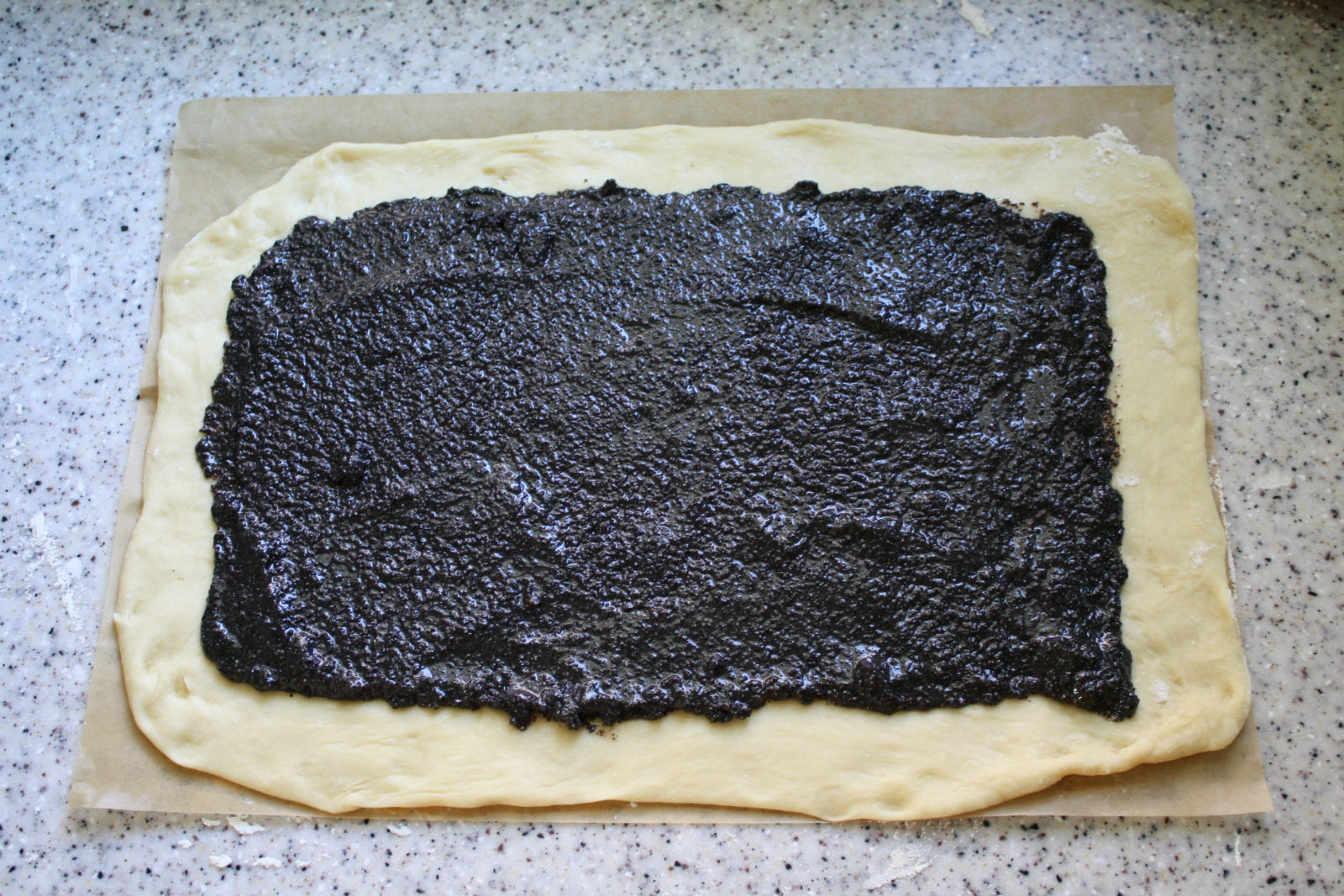
- Carefully begin to roll up the dough, once you’ve reached the edge, brush it with a little of the egg wash to help seal it shut. Pinch the edge of the roll together to ensure that the filling doesn’t leak, also pinch closed each end of the roll so they do not leak either. Carefully transfer the roll seam side down onto the baking sheet. Make slits in the top of the dough; this will help keep the poppy seed roll from bursting. Repeat the process with the second half of the dough.
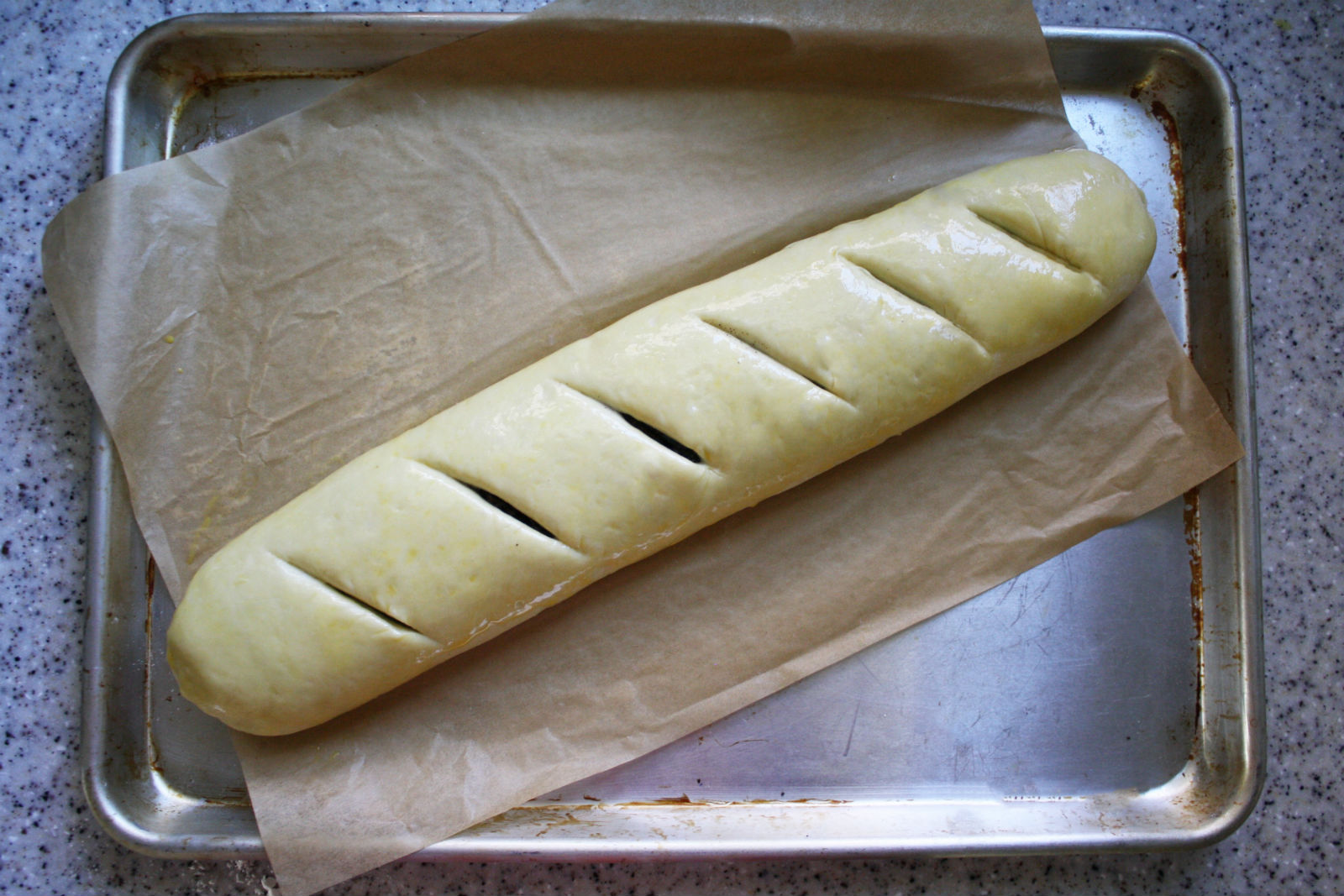
- Preheat the oven to 350°F. Cover the rolls with a clean kitchen towel or a loose piece of plastic wrap and allow to rise again for 30 minutes. Before going in the oven, generously brush the pastry with the egg wash. Make sure the oven racks are on the top and lower thirds of the oven, and place each baking sheet on one of the racks.
- Bake for 30-40 minutes, rotating the rolls once after 15 minutes. Bake until deep golden brown. Allow to cool, then slice and serve.
Notes
- You can make the filling 1-2 days in advance and store it in the fridge.
- The dough needs to rise for around 1½ hours.
- Poppy seed rolls can keep up to five days in an airtight container.
- Prep Time: 3 hours
- Cook Time: 30-40 minutes
- Category: Dessert
- Method: Baking
- Cuisine: Holiday
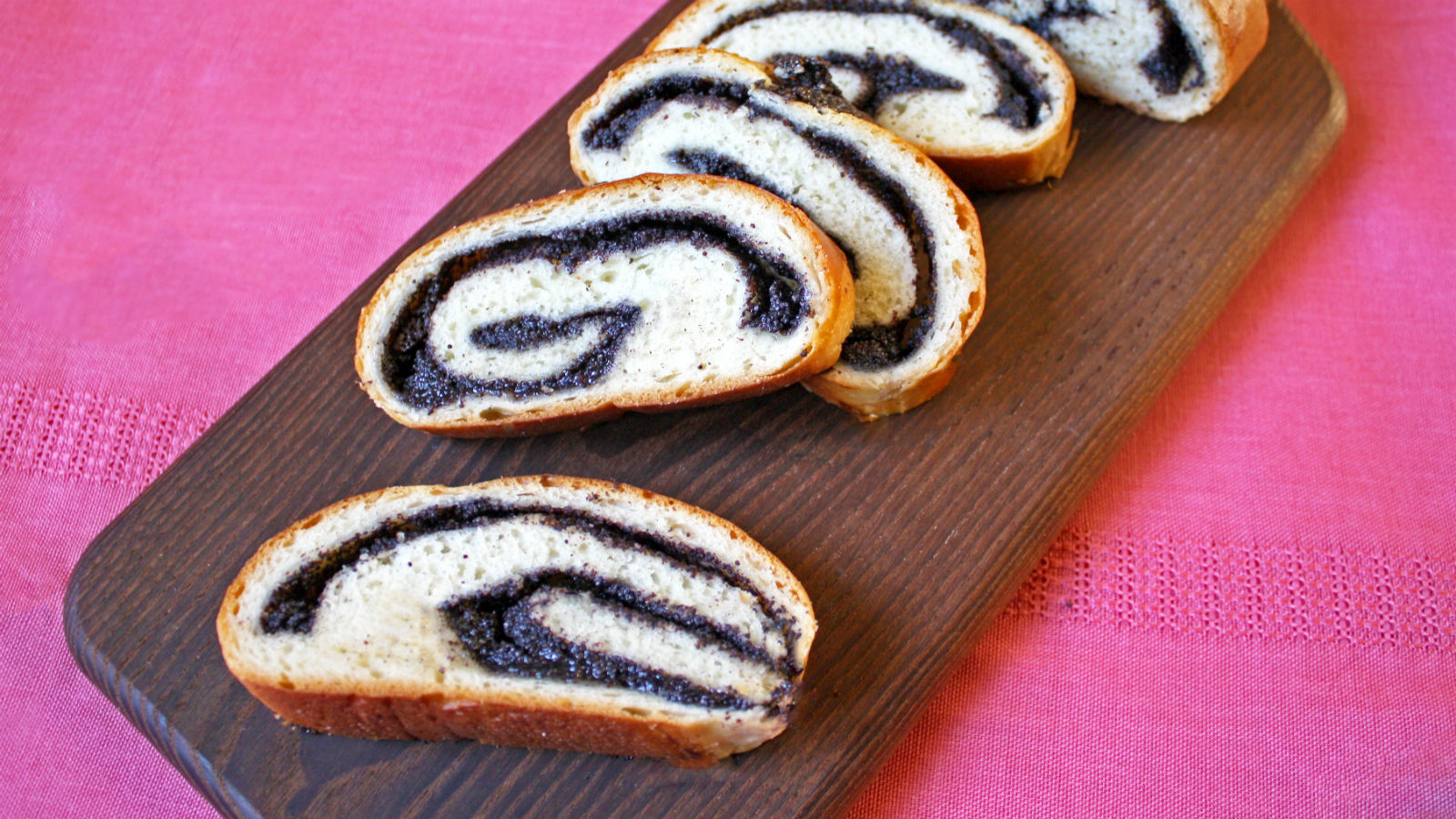



Your looks great. I make my Mom’s recipe, her dough has sour cream in the ingredients. It’s a beautiful dough. I’ve quit looking for the large quantity of poppyseeds required and then grinding in her antique grinder. No i use canned. It is harder to spread and a bit sweeter. I wonder if i should thin it somehow. Any suggestions?